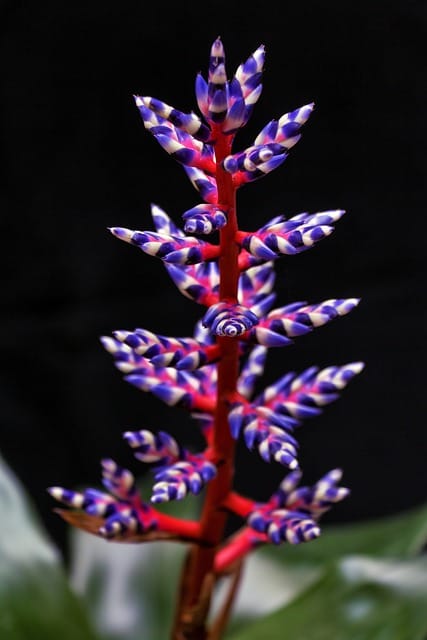How to grow Bromeliads
Bromeliads are unique and colorful plants that make great additions to any indoor setting

In this article:
- Introduction to Bromeliads
- Choosing the Right Bromeliad Variety
- Indoor Conditions for Bromeliads
- Potting and Repotting Bromeliads
- Watering Bromeliads
- Fertilizing Bromeliads
- Humidity and Temperature for Bromeliads
- Providing Adequate Light
- Pruning and Propagating Bromeliads
- Dealing with Common Pests and Diseases
- Displaying Bromeliads in Your Home
- Tips for Bromeliad Care in Different Seasons
- Conclusion and Final Thoughts
Introduction to Bromeliads
Bromeliads are unique and colorful plants that make great additions to any indoor setting. They belong to the Bromeliaceae family, which includes over 3,000 different species. Bromeliads are known for their vibrant foliage, exotic flowers, and ability to thrive in a wide range of environments.
Choosing the Right Bromeliad Variety
When selecting bromeliads for your indoor garden, it's important to consider the specific variety that suits your needs and preferences. Some popular bromeliad species include Aechmea, Guzmania, Tillandsia, and Neoregelia. Each variety has its own unique characteristics and care requirements.
Indoor Conditions for Bromeliads
Bromeliads thrive in warm and humid conditions, making them well-suited for indoor environments. They prefer temperatures between 60°F to 80°F (15°C to 27°C) and humidity levels of around 50% to 60%. It's important to provide adequate air circulation to prevent the growth of mold and stagnant air around the plants.
Potting and Repotting Bromeliads
Bromeliads usually come potted in a nursery or garden center. However, if you want to repot them, make sure to use a well-draining potting mix that is specifically designed for bromeliads. Avoid using regular potting soil, as it may retain too much moisture and cause root rot.
Watering Bromeliads
Watering bromeliads can be a bit different compared to other houseplants. Instead of watering the soil, you should focus on watering the central cup or tank of the bromeliad, where it naturally collects water. It's important to keep the cup filled with water at all times and change it regularly to prevent bacterial growth.
Fertilizing Bromeliads
Bromeliads have low nutritional requirements, so they don't require frequent fertilization. A diluted liquid fertilizer specifically formulated for bromeliads can be applied every two to three months during the growing season. It's important to follow the manufacturer's instructions for proper dosage and frequency.
Humidity and Temperature for Bromeliads
Humidity is crucial for bromeliads to thrive indoors. To increase humidity levels, you can place a tray filled with water near the bromeliads or use a humidifier. Misting the foliage occasionally can also help. Additionally, maintaining a consistent temperature within the recommended range will contribute to their overall health and growth.
Providing Adequate Light
Bromeliads enjoy bright, indirect light, but they can also tolerate lower light conditions. Place your bromeliads near a window that receives filtered light or use artificial grow lights if natural light is limited. Avoid exposing them to direct sunlight, as it can scorch their leaves.
Pruning and Propagating Bromeliads
Pruning bromeliads is generally minimal and primarily involves removing dead or dying leaves to maintain the plant's appearance. To propagate bromeliads, wait for the plant to produce offsets or "pups" that can be separated and potted individually. This can help expand your bromeliad collection or share plants with others.
Dealing with Common Pests and Diseases
Bromeliads are generally resilient and not prone to many pests or diseases. However, some common issues include scale insects, mealybugs, and fungal diseases. Regularly inspect your plants for any signs of infestation or disease and promptly treat them with appropriate insecticides or fungicides if necessary.
Displaying Bromeliads in Your Home
Bromeliads can be displayed in various ways to enhance the aesthetics of your indoor space. You can place individual plants in decorative pots or group them together in a terrarium or hanging basket. Mounting bromeliads on pieces of driftwood or cork bark creates a beautiful natural display. Experiment with different arrangements to find what suits your style and living area.
Tips for Bromeliad Care in Different Seasons
Bromeliads may require slight adjustments in care during different seasons. In winter, when indoor heating tends to dry out the air, providing extra humidity through misting or an indoor humidifier is crucial. In summer, when temperatures rise, ensure that your bromeliads aren't exposed to direct sunlight or extreme heat.
Conclusion and Final Thoughts
Growing bromeliads indoors can be a rewarding experience. With the right care and attention to their specific needs, these stunning plants will grace your home with their unique beauty and vibrant colors. Remember to provide suitable conditions, water regularly, fertilize sparingly, and maintain adequate humidity and light levels to keep your bromeliads thriving year-round.
